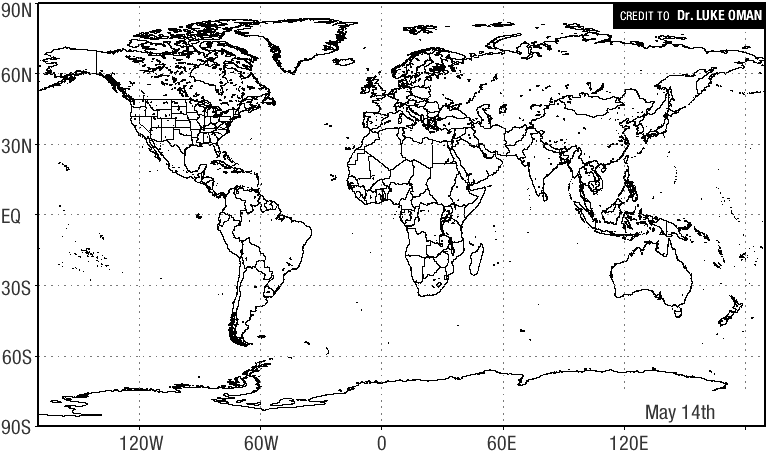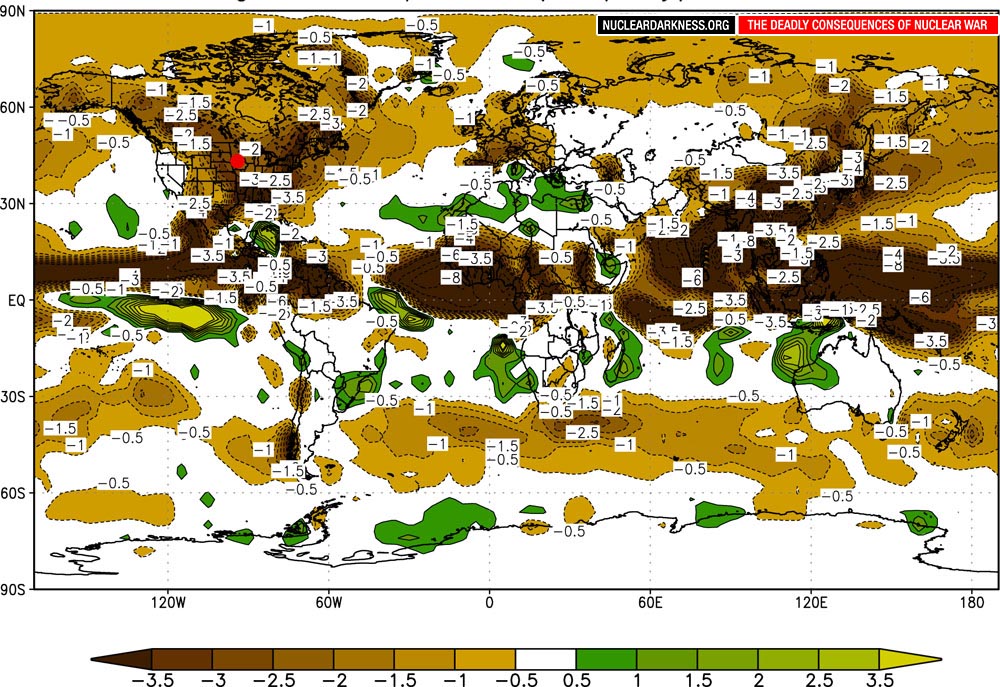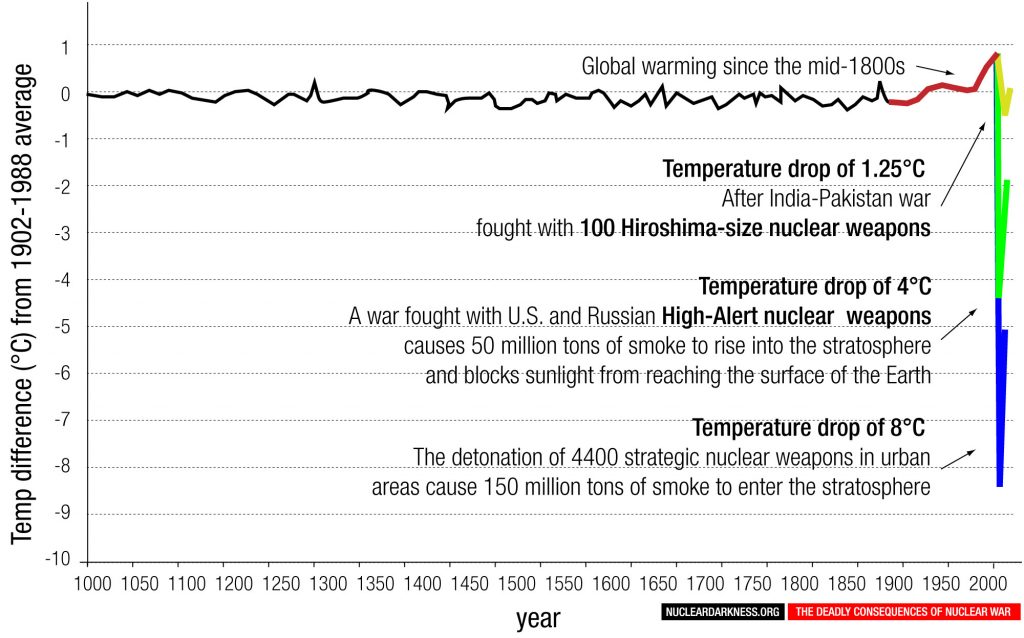
Following a large nuclear war fought between the US and Russia (could include China, and NATO member states), nuclear detonations in cities and industrial areas would create enormous nuclear firestorms that scientists predict will produce approximately 150 million tons of smoke.
Most of this dark smoke would quickly rise above cloud level into the stratosphere. High winds in the stratosphere will spread around the world in about 10 days time. The smoke will then form a dense global stratospheric smoke layer, which will include both the Northern and Southern Hemispheres.
Because the smoke is above cloud level and cannot be rained out, the smoke layer will remain in the stratosphere for ten years or longer, where it will act to block warming sunlight from reaching the surface of the Earth. In the post-war Northern Hemisphere, during a cloudy day at noon, light levels would be similar to what we experience now at midnight during a full moon.
Without warming sunlight the Earth will dramatically cool down. Average daily temperatures will drop below freezing and remain below freezing every day for one to three years. Temperatures would be colder than those experienced during the last Ice Age.
Following a large nuclear war, it would be too cold to grow food crops for at least years. Most humans and land animals — including those not in the war zones — would eventually die from starvation in a Nuclear Famine.
- 1600 to 2000 US and Russian strategic nuclear weapons are launched (in 2 to 14 minutes) at targets in the US, Europe and Russia.
- Some fraction of the remaining 1600 to 2000 deployed and operational US and Russian nuclear weapons are also detonated
- Hundreds of large cities in the U.S., Europe and Russia are engulfed in massive nuclear firestorms, which burn urban areas covering tens or hundreds of thousands of square miles/kilometers.
- 150 million tons of smoke produced by the firestorms rises above cloud level, into the stratosphere, where it quickly spreads around the world and forms a dense stratospheric smoke layer.
- The dense stratospheric smoke layer will remain for at least ten years.
- The smoke blocks up to 70% of warming sunlight from reaching the Earth’s surface in the Northern Hemisphere, and up to 35% of the sunlight is also blocked in the Southern Hemisphere.
- In the Northern Hemisphere, the noonday sun would resemble a full moon at midnight.
- In the absence of warming sunlight, surface temperatures on Earth become as cold or colder than they were 18,000 years ago at the height of the last Ice Age
- There would be rapid cooling of more than 38 degree Fahrenheit (20°C) over large areas of North America and of more than 57 degrees Fahrenheit (30°C) over much of Eurasia, including all major agricultural regions
- Minimum daily temperatures in the central regions of the Northern Hemisphere drop below freezing each day for 1 to 3 years.
- Nightly killing frosts would occur for many years.
- Average global precipitation would be reduced by 45% due to the prolonged cold.
- Growing seasons would be virtually eliminated for at least 10 years.
- World grain reserves would be exhausted in a few months.
- The inability to grow food crops for years would cause most humans and land-based animals to starve to death.
- Massive amounts of radioactive fallout would be generated and spread both locally and globally. The targeting of nuclear reactors would significantly increase fallout of long-lived isotopes.
- Gigantic ground-hugging clouds of toxic smoke would be released from the fires; enormous quantities of industrial chemicals would also enter the environment.
- Already stressed land and marine ecosystems would collapse.
- It would be impossible for many living things to survive the extreme rapidity and degree of changes in temperature and precipitation, combined with drastic increases in UV light, massive radioactive fallout, and massive releases of toxins and industrial chemicals.
- A mass extinction event would occur, similar to what happened 65 million years ago, when the dinosaurs were wiped out following a large asteroid impact with Earth (70% of species became extinct, including all animals greater than 25 kilograms in weight).
- Even humans living in shelters equipped with many years worth of food, water, energy, and medical supplies would probably not survive in the hostile post-war environment.
Climatic changes resulting from nuclear conflict would occur many thousands of times faster – and thus would likely be far more catastrophic – than the climatic changes predicted as a result of global warming.1 The rapidity of the war-induced changes, appearing in a matter of days and weeks, would allow human populations and the whole plant and animal kingdoms no time to adapt.
The same methodology used to predict global weather and global warming were also used to predict global cooling resulting from nuclear war. These modern techniques and computer models have been highly successful in describing the cooling effects of volcanic clouds.2
The figure below compares the predicted drops in average surface temperatures in the Northern Hemisphere caused by small, moderate and large nuclear conflicts are contrasted with the effects of global warming during the last 1000 years.
The 8 degree C drop (15 degree F) would create average surface temperatures colder than those experienced 18,000 years ago at the height of the last Ice Age.
Northern Hemisphere average surface air temperatures during the last 1000 years contrasted with forecast temperature drops from a range of nuclear conflicts.3
There are other important considerations which must be made when estimating the overall environmental and ecological impacts of nuclear war. These include the release of enormous amounts of radioactive fallout, pyrotoxins (poisonous gases produced in large fires) and toxic industrial chemicals into the ecosystems. There will also be massive increases in the amount of deadly ultraviolet light which will reach the surface of the Earth as a result of ozone depletion (no calculations on ozone depletion from a large nuclear war have been done using modern climate models, but peer-reviewed studies predict massive depletion from nuclear conflict using only a tiny fraction of the current global nuclear arsenal).
All these by-products of nuclear war must be taken into account when comparing the danger of nuclear conflict to other potential dangers now confronting humanity and life on Earth.
- This comparison is not meant to minimize the dangers of global warming, which warrant grave concern, rather it is intended to make the point that the potential environmental dangers posed by nuclear war should receive at least as much attention as is that now being afforded to the issue of global warming.
- Robock A, Oman L, Stenchikov G (2007b). Nuclear winter revisited with a modern climate model and current nuclear arsenals: Still catastrophic consequences. Journal of Geophysical Research, vol. 112, D13107, doi:10.1029/2006JD008235..
- Robock A, Oman L, Stenchikov G (2007b). Nuclear winter revisited with a modern climate model and current nuclear arsenals: Still catastrophic consequences. Journal of Geophysical Research, vol. 112, D13107, doi:10.1029/2006JD008235; Figure 9.
Reduced Global Precipitation 1 year after 150 million tons of smoke enter the stratosphere
Edit “Reduced Global Precipitation 1 year after 150 million tons of smoke enter the stratosphere”

Precipitations changes (mm/day) in response to 150 million tons of smoke entering the stratosphere, averaged for June, July and August of the first year following the smoke injection. There are large reductions over large regions, especially those affected by the North Amercian, Asian and African summer monsoons.
The global changes in average surface temperatures caused by the detonation of 100 Hiroshima-size weapons in the cities of India and Pakistan (50 weapons in each nation) would act to decrease the length of growing seasons in the Northern Hemisphere. In some places like Canada (see map below) the decreases in average temperature would have drastic effects upon the ability to grow the annual wheat crop. It is predicted that wheat exports would cease for three or more years; the global decreases in grain production would be severe and would likely lead to a global nuclear famine affecting hundreds of millions of already hungry people (see the article by Dr. Ira Helfand, “An Assessment of the Extent of Projected Global Famine Resulting from Limited, Regional Nuclear War“)
Reduced Canadian wheat-growing potential after small drops in average temperature

Map showing the present principal area of Canadian wheat production, and the reduction that would result from small decreases in average surface temperature.
Source
Scientific Committee on Problems of the Environment (SCOPE), Figure 4.8a on p. 302 of SCOPE Report 28, Environmental Consequences of Nuclear War: Vol. I, Physical and Atmospheric Effects by A. Ptticok, T.P. Ackerman, P.J. Crutzen, M.C. MacCracken, C.S. Shapiro & R.P. Turco (eds.), 1986, 2nd ed. 1989, Wiley & Sons, New York; Vol. II, Ecological and Agricultural Effects by M.A. Harwell and T.C. Hutchinson (eds.), 1985, 2nd ed. 1989, Wiley & Sons, New York; PDF files available at www.icsu-scope.org.
